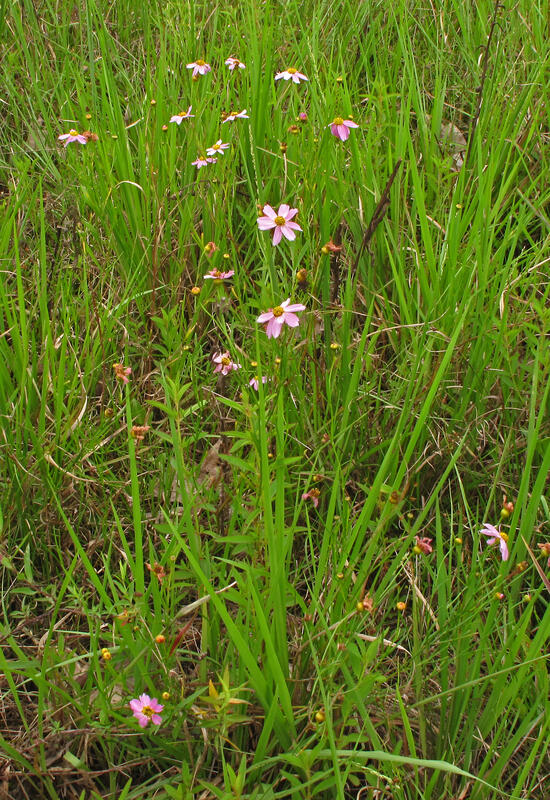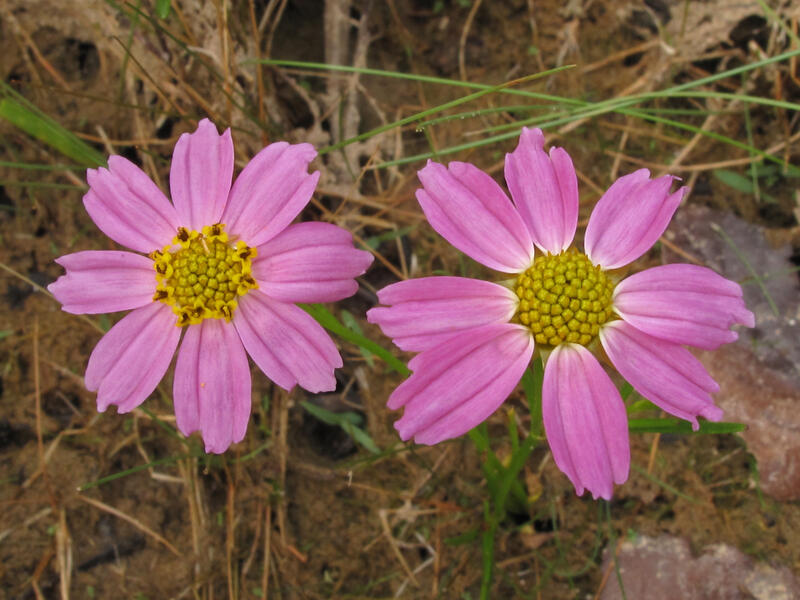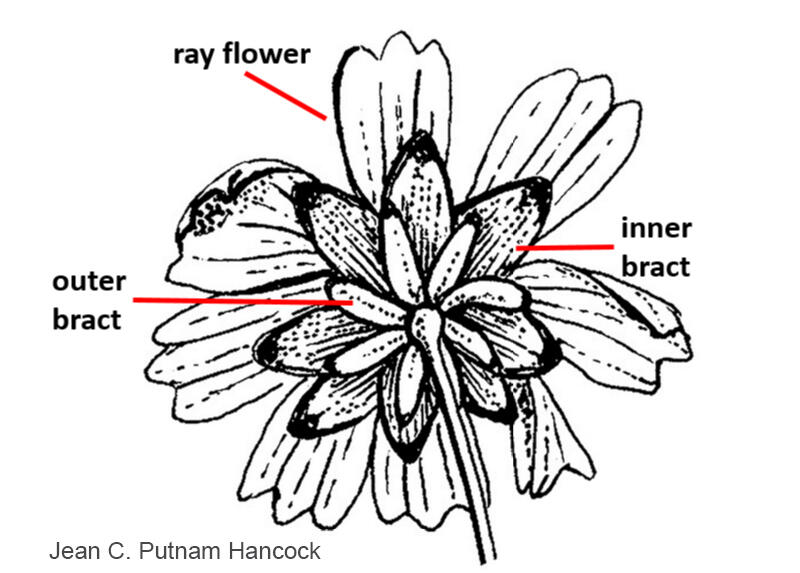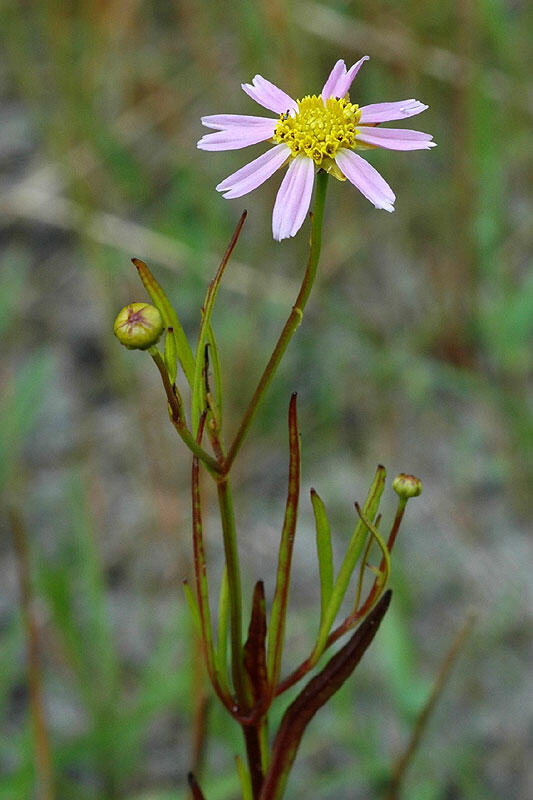







Loading profile. Please wait . . .
Coreopsis rosea Nutt.
Pink Tickseed




Federal Protection: No US federal protection
State Protection: No Georgia state protection
Global Rank: G3
State Rank: S1
Element Locations Tracked in Biotics: Yes
SWAP 2015 Species of Greatest Conservation Need (SGCN): Yes
SWAP 2025 Species of Greatest Conservation Need (SGCN): Yes
2025 SGCN Priority Tier: High Conservation Concern
Element Occurrences (EOs) in Georgia: 4
Habitat Summary for element in Georgia: Banks of blackwater rivers; pond shores
Perennial herb with erect, hairless, simple or branched stems 4 - 12 inches (10 - 60 cm) tall (occasionally much taller). Leaves 0.8 - 2.4 inches (2 - 6 cm) long, opposite, very narrow (1 - 3 mm wide) and needle-like, rarely with 1 or 2 lobes, hairless. Flower heads are held at the tips of erect stalks up to 2.4 inches (2 - 6 cm) long; each head is surrounded at the base by two series of bracts: the inner bracts are triangular in shape and curve upwards; the outer bracts are narrowly oblong and spread outwards (see drawing below). Ray flowers are usually 8 in number (rarely up to 13), pink or white, 0.4 - 0.6 inch (0.9 - 1.5 cm) long, usually 3-lobed at the tip. Disk flowers numerous, cream-colored or yellow, each with 4 lobes and 4 stamens. Fruits are about 0.1 inch (1.3 - 1.8 mm) long, dry, seed-like, narrowly oblong, and without wings.
There are only two native species of Coreopsis with pink ray flowers, Pink Tickseed and Georgia Tickseed (Coreopsis nudata). The latter is a common Coastal Plain species that lacks leaf blades. Its narrow leaf stalks are 2 - 12 inches (5 - 30 cm) long and look and function as leaves; they are alternate. It occurs in Coastal Plain pine savannas and bogs.
There are 3 rare species of Coreopsis in Georgia:
Ciliate-leaf Tickseed (Coreopsis integrifolia) occurs on streambanks and in floodplains of blackwater streams in the Coastal Plain. For more information see: https://georgiabiodiversity.org/portal/profile.html?group=plants&es_id=17909&fus_tab_id=1HsRRHkW2qqMS1MunY5KMrvThVR_5C8sAX2-pFapk&group=plant
Broad-leaved Tickseed (Coreopsis latifolia) occurs in mature deciduous forests with open understory in the mountains. For more information, see: https://georgiabiodiversity.org/portal/profile?group=plants&es_id=16819
Pink Tickseed (Coreopsis rosea) occurs in a wet meadow in Georgia's Blue Ridge and on a shoreline of an artificial lake in the upper Piedmont. For more information, see: https://www.georgiabiodiversity.org/portal/profile?group=plants&es_id=20663
In Georgia, Pink Tickseed occurs in a wet meadow in the Blue Ridge and on a shoreline of an artificial lake in the upper Piedmont. Range-wide, it occurs on the shorelines of ponds and streams with naturally fluctuating water levels.
Pink Tickseed is a perennial herb that reproduces vegetatively by sprouting from underground stems (rhizomes) and by rooting of fragmented rhizomes and stems. It also reproduces sexually, flowering within two growing seasons after germination. It requires cross-pollination to set viable seed and attracts bees and other pollinators with its brightly colored flower heads. Seed dispersal is not well understood; Pink Tickseed fruits lack the wings and bristles that aid seed dispersal in other tickseed species. Although it tolerates low-nutrient soils and prolonged flooding, it is a poor competitor and, in the absence of fire, is quickly outcompeted by woody and/or aggressive plants.
Pink Tickseed is most conspicuous when it flowers August–September. Its slender stems and narrow, bladeless leaves make it very difficult to spot at other times of the year.
In Georgia, Pink Tickseed occurs in a mountain seepage bog in the Blue Ridge and on a shoreline of an artificial lake in the upper eastern Piedmont. Range-wide, Pink Tickseed occurs in the Coastal Plain of southern Nova Scotia then sporadically south in Massachusetts, Rhode Island, Long Island (New York), New Jersey, Pennsylvania, Delaware, Maryland, South Carolina and Georgia. It is rare throughout its range. Pink Tickseed is an important horticultural species with several cultivars; plants occurring outside this known range are likely to be garden escapes.
Range-wide, Pink Tickseed is threatened by habitat destruction caused by shoreline development, heavy recreational use of pond and lake margins (especially by all-terrain vehicles), alteration of the naturally fluctuating hydrology of ponds and streams by dam construction and lake-level stabilization, fertilizer inputs from surrounding pastures and farms leading to pond eutrophication, competition from exotic and aggressive native plants, and fire suppression. Alteration of natural flooding and drawdown regimes as a result of climate change are likely to be a threat.
| Threat 1 | Threat 2 | Threat 3 | |
|---|---|---|---|
| General Threat | Agriculture & aquaculture | Energy production & mining | Transportation & service corridors |
| Specific Threat | None | None | None |
Coreopsis rosea is ranked S1 by the Georgia Department of Natural Resources, indicating that it is critically imperiled in the state. It is also ranked G1 indicating that it is critically imperiled throughout its entire range. Two populations have been observed recently in Georgia, one in a state park, the other in a Nature Conservancy Preserve where it is frequently monitored. The state park population is threatened by foot and recreational vehicle traffic. A third population described in Effingham County in 1814 has never been relocated.
Protect known populations and adjacent shorelines of lakes and streams from all-terrain vehicles and other heavy recreation use. Use prescribed fire to eliminate woody competition. Monitor sites for exotic pest plant invasion and remove exotic species. Monitor sites for the effects of climate change. Research on isozyme diversity indicates that Coreopsis rosea has “very high levels of population differentiation, indicating genetic differences between populations. Protecting several populations of [this] species throughout [its] geographic range would be necessary in order to preserve as much genetic variation as possible.” (Cosner and Crawford 1994).
COSEWIC. 2012. Assessment and status report on the Pink Coreopsis, Coreopsis rosea, in Canada. Committee on the Status of Endangered Wildlife in Canada. Canadian Wildlife Service, Environment and Climate Change Canada, 351 St. Joseph Blvd, 16th floor, Gatineau QC K1A 0H3. 819-938-4125. https://tinyurl.com/y6sltgf2 Email: ec.cosepac-cosewic.ec@canada.ca
Cosner, M.E. and D.J. Crawford. 1994. Comparisons of isozyme diversity in three rare species of Coreopsis (Asteraceae). Systematic Botany 19(3): 350-358. https://www.jstor.org/stable/2419761?seq=1#metadata_info_tab_contents
Cronquist, A. 1980. Vascular Flora of the Southeastern United States: Volume 1, Asteraceae. University of North Carolina Press, Chapel Hill.
GADNR. 2019. Element occurrence records for Coreopsis rosea. Georgia Department of Natural Resources, Wildlife Resources Division. Social Circle, Georgia.
Flora of North America Editorial Committee. 2006. Coreopsis rosea. Flora of North America North of Mexico. Vol. 21. http://www.efloras.org/florataxon.aspx?flora_id=1&taxon_id=250066433
Loehrlein, M. and S. Siqueira. 2005. Self-incompatibility in Pink Tickseed, Coreopsis rosea Nutt. HortScience 40(4): 1001-1002. https://www.researchgate.net/publication/330797096_234_Self-incompatibility_in_Pink_Tickseed_Coreopsis_rosea_Nutt
NatureServe. 2019. Species account for Coreopsis rosea. NatureServe Explorer: an online encyclopedia of life, Version 7.1. NatureServe, Arlington, Virginia. Accessed 8 June 2019. https://explorer.natureserve.org/Taxon/ELEMENT_GLOBAL.2.157053/Coreopsis_rosea
Weakley, A.S. 2015. Flora of the southern and mid-Atlantic States. University of North Carolina Herbarium, University of North Carolina, Chapel Hill. http://www.herbarium.unc.edu/flora.htm
Linda G. Chafin
Linda G. Chafin, 2 November 2019: original account


